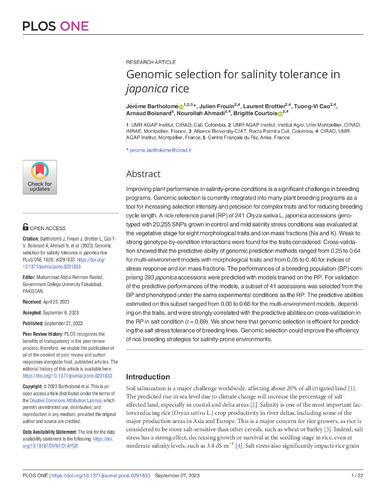Improving plant performance in salinity-prone conditions is a significant challenge in breeding programs. Genomic selection is currently integrated into many plant breeding programs as a tool for increasing selection intensity and precision for complex traits and for reducing breeding cycle length. A rice reference panel (RP) of 241 Oryza sativa L. japonica accessions genotyped with 20,255 SNPs grown in control and mild salinity stress conditions was evaluated at the vegetative stage for eight morphological traits and ion mass fractions (Na and K). Weak to strong genotype-by-condition interactions were found for the traits considered. Cross-validation showed that the predictive ability of genomic prediction methods ranged from 0.25 to 0.64 for multi-environment models with morphological traits and from 0.05 to 0.40 for indices of stress response and ion mass fractions. The performances of a breeding population (BP) comprising 393 japonica accessions were predicted with models trained on the RP. For validation of the predictive performances of the models, a subset of 41 accessions was selected from the BP and phenotyped under the same experimental conditions as the RP. The predictive abilities estimated on this subset ranged from 0.00 to 0.66 for the multi-environment models, depending on the traits, and were strongly correlated with the predictive abilities on cross-validation in the RP in salt condition (r = 0.69). We show here that genomic selection is efficient for predicting the salt stress tolerance of breeding lines. Genomic selection could improve the efficiency of rice breeding strategies for salinity-prone environments.
Bartholomé, J.; Frouin, J.; Brottier, L.; Cao, T.; Boisnard, A.; Ahmadi, N.; Courtois, B.

